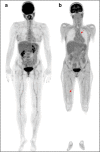Long COVID hallmarks on [18F]FDG-PET/CT: a case-control study
- PMID: 33677642
- PMCID: PMC7937050
- DOI: 10.1007/s00259-021-05294-3
Long COVID hallmarks on [18F]FDG-PET/CT: a case-control study
Abstract
Purpose: The present study hypothesised that whole-body [18F]FDG-PET/CT might provide insight into the pathophysiology of long COVID.
Methods: We prospectively enrolled 13 adult long COVID patients who complained for at least one persistent symptom for >30 days after infection recovery. A group of 26 melanoma patients with negative PET/CT matched for sex/age was used as controls (2:1 control to case ratio). Qualitative and semi-quantitative analysis of whole-body images was performed. Fisher exact and Mann-Whitney tests were applied to test differences between the two groups. Voxel-based analysis was performed to compare brain metabolism in cases and controls. Cases were further grouped according to prevalent symptoms and analysed accordingly.
Results: In 4/13 long COVID patients, CT images showed lung abnormalities presenting mild [18F]FDG uptake. Many healthy organs/parenchyma SUVs and SUV ratios significantly differed between the two groups (p ≤ 0.05). Long COVID patients exhibited brain hypometabolism in the right parahippocampal gyrus and thalamus (uncorrected p < 0.001 at voxel level). Specific area(s) of hypometabolism characterised patients with persistent anosmia/ageusia, fatigue, and vascular uptake (uncorrected p < 0.005 at voxel level).
Conclusion: [18F]FDG PET/CT acknowledged the multi-organ nature of long COVID, supporting the hypothesis of underlying systemic inflammation. Whole-body images showed increased [18F]FDG uptake in several "target" and "non-target" tissues. We found a typical pattern of brain hypometabolism associated with persistent complaints at the PET time, suggesting a different temporal sequence for brain and whole-body inflammatory changes. This evidence underlined the potential value of whole-body [18F]FDG PET in disclosing the pathophysiology of long COVID.
Keywords: Brain hypometabolism; Chronic COVID syndrome; Infection; Inflammation; Long COVID; SARS-CoV-2; [18F]FDG PET/CT.
© 2021. The Author(s), under exclusive licence to Springer-Verlag GmbH Germany, part of Springer Nature.
Conflict of interest statement
Dr. Sollini, Morbelli, Ciccarelli, Morelli, Aghemo and Gelardi have nothing to disclose; Dr. Cecconi reports personal fees from Edwards Lifesciences, personal fees from Directed Systems, and personal fees from Cheetah Medical, outside the submitted work; Dr. Chiti reports other from Sanofi, personal fees from AAA, personal fees from Blue Earth Diagnostics, and personal fees from General Electric Healthcare, outside the submitted work.
Figures




References
-
- Living with Covid19. 2020.
-
- Greenhalgh T, Knight M, A’Court C, Buxton M, Husain L. Management of post-acute covid-19 in primary care. BMJ. British Medical Journal Publishing Group; 2020;370:m3026. - PubMed
MeSH terms
Substances
LinkOut - more resources
Full Text Sources
Other Literature Sources
Medical
Miscellaneous

